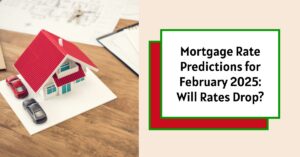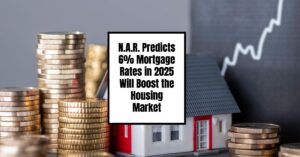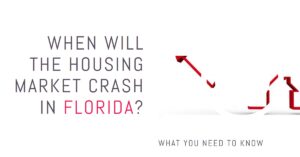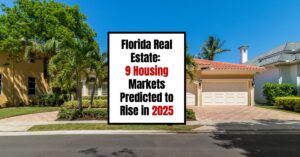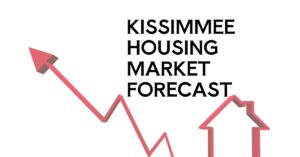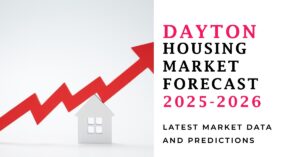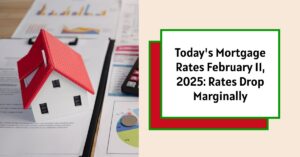If you're eyeing a home purchase or considering a refinance, you're probably wondering about one thing: will mortgage rates drop in February 2025? The short answer, based on current expert forecasts, is that we might see a slight dip, but don't expect a dramatic plunge. Many predict a slow and steady decline over the coming months, but several factors are at play, and it's essential to understand them to make informed decisions.
Mortgage Rate Predictions for February 2025: Will Rates Drop?
Mortgage rates are a complex beast, influenced by a multitude of factors. It's not just about what the Federal Reserve (the Fed) does. While their decisions are a major piece of the puzzle, other economic indicators and even political events can significantly impact where rates ultimately land. It's like trying to predict the weather – you need to look at more than just the temperature!
Here's a breakdown of the key players influencing mortgage rates:
- The Federal Reserve (The Fed): The Fed influences interest rates across the economy. They set the federal funds rate, which is the rate banks charge each other for overnight lending. While this doesn't directly translate into mortgage rates, it has a ripple effect. When the Fed lowers rates, it generally makes borrowing cheaper, which can nudge mortgage rates downward.
- Inflation: Inflation is a big one! When the cost of goods and services rises rapidly, the Fed often steps in to raise interest rates to cool down the economy. High inflation generally leads to higher mortgage rates.
- Economic Data: The Fed doesn't make decisions in a vacuum. They rely heavily on economic data, such as:
- Jobs Reports: These reports reveal new job creation figures and the unemployment rate. A strong job market can signal a healthy economy, potentially leading to higher rates.
- Consumer Price Index (CPI): This measures changes in the prices paid by consumers for goods and services. It's a key indicator of inflation.
- Personal Consumption Expenditures (PCE): This measures consumer spending and is another gauge of inflation.
- 10-Year Treasury Yield: This is the yield (return) on a 10-year U.S. Treasury bond. Mortgage rates tend to follow the trend of the 10-year Treasury yield because mortgage-backed securities (MBS) are often benchmarked against it.
- Mortgage-Backed Securities (MBS): These are bundles of mortgages that are sold to investors. Demand for MBS influences mortgage rates. When investors buy more MBS, it pushes rates down and vice versa.
- Government Policy: Policies from the presidential administration, including things like trade tariffs, can also have an impact. New or increased tariffs, for example, can potentially fuel inflation, which could then lead to higher interest rates.
What Experts Were Predicting for February 2024 (To Get a Sense of Trends)
Looking back can provide some context. In early 2024, analysts generally predicted that mortgage rates would either hold steady or drop slightly in the near term. Remember, this is just a snapshot in time, and those predictions were based on the information available then.
- Fannie Mae: Projected the average 30-year mortgage rate would end the first quarter of the year (so around March) at approximately 6.7%.
- Mortgage Bankers Association (MBA): Predicted a higher rate of 7% for the same period.
What to Expect for February 2025: My Take
Okay, so let's apply that knowledge to February 2025. Predicting the future is impossible, but based on my understanding of the market, here's what I think is most likely:
- A Slow and Steady Decline: I'm leaning toward the consensus view that we'll see a gradual decline in mortgage rates over the next several months. We might see a small dip in February, but it won't be a dramatic drop.
- Focus on Economic Data: Keep a close eye on those economic reports I mentioned earlier (jobs reports, CPI, PCE). These will be crucial in determining the Fed's next moves and, therefore, mortgage rate trends.
- Policy Impact: This is a wild card. Any significant policy changes from the presidential administration could definitely sway the direction of rates, either up or down.
Factors that Could Push Rates Down
- Easing Inflation: If inflation continues to cool down, the Fed might feel comfortable cutting interest rates.
- Weaker Economic Data: A slowdown in the economy (e.g., higher unemployment) could also prompt the Fed to lower rates to stimulate growth.
- Increased Demand for MBS: If investors start buying more mortgage-backed securities, that could put downward pressure on rates.
Factors that Could Keep Rates High
- Persistent Inflation: If inflation remains stubbornly high, the Fed might hold off on cutting rates, or even raise them further.
- Strong Economic Growth: A robust economy could lead to higher rates as the Fed tries to prevent inflation from overheating.
- Geopolitical Instability: Global events (wars, trade disputes, etc.) can create uncertainty and volatility in the markets, which can sometimes lead to higher interest rates.
Where Might Rates Be by the End of 2025?
Looking further out, both Fannie Mae and the MBA have projected that mortgage rates will end 2025 near an average of 6.5%. I think that's a reasonable estimate, but again, it depends heavily on how the economy performs.
Personally, I believe we could see rates settling in the low 6% range by the end of the year. Historically, the national average for a conventional 30-year fixed-rate loan is around 5.5%, and I believe we can get back to that in the coming years. I do not see the potential to reach there by the end of 2025. I foresee a long way to go, and maybe we can reach there by 2027.
Recommended Read:
Mortgage Rates Trends – February 10, 2025
Mortgage Interest Rates Forecast for Next 10 Years
Interest Rate Forecast for Next 10 Years: 2025-2035
Mortgage Rates Expected to Rise Further Due to Strong Jobs Data
What This Means for You: Should You Buy or Refinance?
Deciding whether to buy a home or refinance an existing mortgage is a personal decision that depends on your unique circumstances. Here are some things to consider:
- Your Financial Situation: Can you comfortably afford the monthly mortgage payments, property taxes, and insurance? Do you have a solid emergency fund?
- Your Credit Score: A higher credit score will help you qualify for a better interest rate. Aim for a score of 740 or higher.
- Your Down Payment: A larger down payment will result in a lower interest rate.
- Your Goals: Are you planning to stay in the home for a long time? If so, buying might make more sense. If you need more flexibility, renting might be a better option.
Expert Tips for Homebuyers
Here's some expert advice to help you navigate the home-buying process:
- Build your credit score. A good credit score will qualify you for a better mortgage rate.
- Save for a bigger down payment. A larger down payment leads to a smaller loan and a lower interest rate.
- Shop for mortgage lenders. Compare offers from multiple lenders to get the best rate.
- Consider renting. Don't rush into buying. Renting can provide flexibility and lower upfront costs.
- Consider mortgage points. You can lower your mortgage rate by paying mortgage points upfront. One point equals a 0.25% decrease in your rate.
The Bottom Line
While it's impossible to predict the future with certainty, the general consensus is that mortgage rates are likely to decline slowly and steadily over the coming months. Whether that decline starts in February 2025 remains to be seen, but it's important to stay informed and consult with a mortgage professional and real estate agent to make the best decision for your situation.
Work with Norada in 2025, Your Trusted Source for
Real Estate Investing
With mortgage rates fluctuating, investing in turnkey real estate
can help you secure consistent returns.
Expand your portfolio confidently, even in a shifting interest rate environment.
Speak with our expert investment counselors (No Obligation):
(800) 611-3060
Recommended Read:
- Mortgage Rates Forecast for the Next 3 Years: 2025 to 2027
- 30-Year Mortgage Rate Forecast for the Next 5 Years
- 15-Year Mortgage Rate Forecast for the Next 5 Years
- Why Are Mortgage Rates Going Up in 2025: Will Rates Drop?
- Why Are Mortgage Rates So High and Predictions for 2025
- NAR Predicts 6% Mortgage Rates in 2025 Will Boost Housing Market
- Mortgage Rates Predictions for 2025: Expert Forecast
- Will Mortgage Rates Ever Be 3% Again: Future Outlook
- Mortgage Rates Predictions for Next 2 Years
- Mortgage Rate Predictions for Next 5 Years
- Mortgage Rate Predictions for 2025: Expert Forecast
- Mortgage Rate Predictions: Why 2% and 3% Rates are Out of Reach
- How Lower Mortgage Rates Can Save You Thousands?
- How to Get a Low Mortgage Interest Rate?
- Will Mortgage Rates Ever Be 4% Again?
